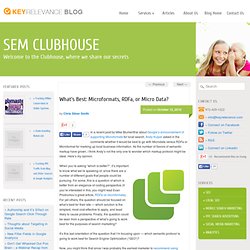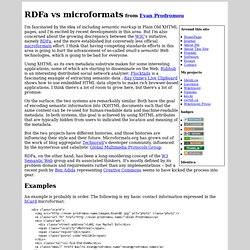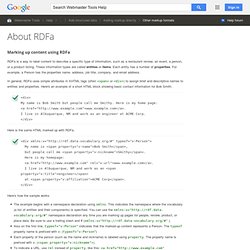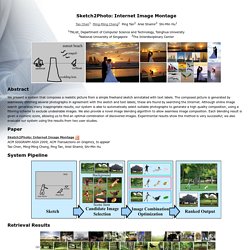

Welcome to Pingar. Sindice - The semantic web index. TextWise LLC. Tagaroo » Make blogging better! Slashtag search. Verifying and Filtering News (FOSS) OpenPublish - Open-Source Online News Publishing. Home. Your Mobile Life, Better. Fuel your fascination. What’s Best: Microformats, RDFa, or Micro Data? In a recent post by Mike Blumenthal about Google’s announcement of supporting Microformats for local search, Andy Kuiper asked in the comments whether it would be best to go with Microdata versus RDFa or Microformat for marking up local business information.

As the number of flavors of semantic markup have grown, I think Andy’s not the only one to wonder which markup protocol might be ideal. Here’s my opinion. When you’re asking “which is better?” , it’s important to know what we’re speaking-of, since there are a number of different goals that people could be pursuing. For some, this is a question of which is better from an elegance-of-coding perspective (if you’re interested in this, you might read Evan Prodromou’s great article, RDFa vs microformats). It’s this last orientation of the question that I’m focusing upon — which semantic protocol is going to work best for Search Engine Optimization (“SEO”)? RDFa vs microformats from Evan Prodromou. I'm fascinated by the idea of including semantic markup in Plain Old XHTML pages, and I'm excited by recent developments in this area.

But I'm also concerned about the growing discrepancy between the W3C's initiative, namely RDFa, and the more established but conversely less official microformats effort. I think that having competing standards efforts in this area is going to hurt the advancement of so-called small-s semantic Web technologies, which is going to be bad for everyone. Using XHTML as its own metadata substrate makes for some interesting applications, some of which are starting to disseminate on the Web. Rubhub is an interesting distributed social network analyzer; Flocktails is a fascinating example of extracting semantic data ; Ray Ozzie's Live Clipboard shows how to use embedded HTML data objects to make rich browser-based applications.
I think there's a lot of room to grow here, but there's a lot of promise. On the surface, the two systems are remarkably similar. Microformats. The Open Graph Protocol. About RDFa - Webmaster Tools Help. Marking up content using RDFa RDFa is a way to label content to describe a specific type of information, such as a restaurant review, an event, a person, or a product listing.

These information types are called entities or items. Each entity has a number of properties. For example, a Person has the properties name, address, job title, company, and email address. In general, RDFa uses simple attributes in XHTML tags (often <span> or <div>) to assign brief and descriptive names to entities and properties. <div> My name is Bob Smith but people call me Smithy. Here is the same HTML marked up with RDFa. <div xmlns:v=" typeof="v:Person"> My name is <span property="v:name">Bob Smith</span>, but people call me <span property="v:nickname">Smithy</span>.
Here's how the sample works. The example begins with a namespace declaration using xmlns. Nested items The example above shows contact information about Bob Smith. It is common for one information type to include another. Non-visible content. Yoogli Search. Sketch2Photo. Sketch2Photo: Internet Image Montage Tao Chen1 Ming-Ming Cheng1 Ping Tan2 Ariel Shamir3 Shi-Min Hu1 1TNList, Department of Computer Science and Technology, Tsinghua University 2National University of Singapore 3The Interdisciplinary Center Abstract We present a system that composes a realistic picture from a simple freehand sketch annotated with text labels.

The composed picture is generated by seamlessly stitching several photographs in agreement with the sketch and text labels; these are found by searching the Internet. Paper Sketch2Photo: Internet Image Montage ACM SIGGRAPH ASIA 2009, ACM Transactions on Graphics, to appear Tao Chen, Ming-Ming Cheng, Ping Tan, Ariel Shamir, Shi-Min Hu System Pipeline Retrieval Results Composition Results Video Supplementary Materials.